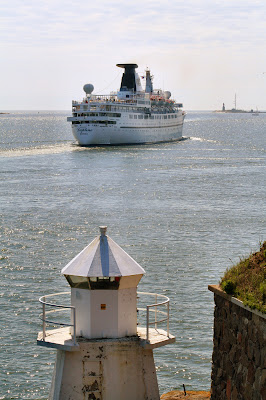Princess Daphne
IMO 5282627
Name history:
Port Sydney, Akirotiri Express, Daphne, Switzerland, Ocean Monarch, Princess Daphne
Built 1955, Swan, Hunter & Wigham Richardson Newcastle, United Kingdom
Tonnage 15 833 GT
Length 162,37 m
Width 21,34 m
Draught 7,80 m
592 passengers
2 Doxford-Wallsend diesels, combined 9 709 kW
2 propellers
1 bow thruster
Speed 16 knots
Princess Daphne is a classic-looking ship with a diverse history. She was originally built in 1955 as the refridgerated cargo ship
Port Sydney for Port Line's UK-New Zealand-Australia service. A sister ship,
Port Melbourne, followed later the same year.
In 1972 the
Port Sydney and
Port Melbourne were sold to the Greenk shipping tycoon John C. Carras (alternatively spelled as "Karras", but the former appears to be the preferred English translitteration) with the original intention of being converted into car/passenger ferries. With this in mind the
Port Sydney was renamed
Akirotiri Express while her sister became the
Therisos Express. Plans changed however, and when the ships sailed to the Chalkis shipayrd in Greece it was with the intention of being rebuilt into luxurious cruise ships for approximately 400 passengers.
When the ships re-emerged from the shipyard in 1975-1976 they were completely transformed from their original unattractive freighter looks into sleek, well-rounded cruise ships. Only the shape of their hulls with the pronounced sheer betrayed their origins from 20 years past. The
Akirotiri Express, now renamed
Daphne was the first to be completed in 1975. Her sister followed as the
Danae the following year. Under the banner of Carras Cruises the sisters sailed to varying destinations around the world, including the Mediterranean, South America, the Amazon River and East Asia. In the latter area the
Danae became the first western cruise ship to call in the People's Republic of China in 1977. The
Daphne meanwhile was to cruise from the United States to Cuba, but this plan had to be scrapped due to the difficult political situation and a bomb threat directed at the ship.
While Carras Cruises offered interesting iteneraries, they failed to make themselves known to the wider travelling public. An additional problem was the fierce competition from Royal Viking Line with their newer, purpose-built ships. In 1978 the
Daphne was chartered to Lauro Lines (the predecessor of todays MSC Cruises) for year. Following the end of the charter to Lauro she was chartered to Costa Cruises for five year from 1979 onwards. Later in 1979, after just four year of operation, Carras Cruises closed down and the
Danae was also chartered to Costa.
The sisters retained their names while sailing with Costa, and they stayed with the company for 11 years (Costa purchased the sisters at the end of the original charter agreements in 1984). In 1990 Costa founded a joint subsidiary, Prestige Cruises, with the Soviet Union's Sovcomflot and the
Daphne and
Danae were transferred to this company—still without a change in name. The
Danae was badly damaged during a shipyard fire in 1991 and she was declared a total loss. Although sold for scrap she was eventually sold and repaired by her new owners.
Daphne meanwhile continued sailing for Prestige Cruises for the time being. Sometime between 1993 and 1996 Sovcomflot pulled out of the Prestige Cruises arrangement and the
Daphne returned to Costa Cruises. In 1997 the
Daphne was sold to Swiss owners and renamed
Switzerland for service with Leisure Cruises. In 2001 the
Switzerland was laid up at Marseille. In 2002 she was sold to Majestic International Cruises, renamed
Ocean Monarch and chartered variously to Page & Moy, Hansa Kreuzfahrten and Golden Sun Cruises. In 2005 she was also used as a hospital ship in Sri Lanka following the Boxing Day Tsunami. In 2007 the
Ocean Monarch cruised for Majestic International's subsidiary Monarch Classic Cruises.
In 2007 the
Ocean Monarch was sold to the Portugal-based Classic International Cruises. Classic International had bought the ex-
Danae (by that time known as
Baltica) in 1996 and had renamed her
Princess Danae. To match the name of her sister and again-fleetmate the
Ocean Monarch was renamed
Princess Daphne in 2008. Between 2008 and 2010 the
Princess Daphne spent the winter seasons cruising with her owners in the Far East, while for the summers she was chartered to Hansa Kreuzfahrten for European cruising.
[The following segment was added on 3 June 2014:] Classic International Cruises ceased trading in late 2012 and the
Princess Daphne, alongside the rest of the company fleet, was laid up. While the rest of the former CIC fleet was sold to Rui Alegre, who formed
Portuscale Cruises to operate them, the
Princess Daphne was returned to CIC's owners, the brothers Aleksandros and Emilios Potamianos. Probably the Potamianos brothers had ambitions to return the
Princess Daphne to cruise service—possibly even using the CIC name. This did not come to pass, and in May 2014 the
Princess Daphne left layup for one last voyage to the shipbreakers of Alang.
Photographs below are of the
Princess Daphne in Helsinki on 17 May 2009 during one of her charters to Hansa Kreuzfahrten. Click on the individual images to view full size.
 |
| At the cruise quay in Katajanokka. |
 |
| Another photo from the Katajanokka cruise quay. |
 |
| In the Kustaanmiekka strait, following the train of her Hansa Kreuzfahrten fleetmate Delphin that was also in Helsinki on the same day. |
 |
| Heading south to the Bay of Finland, with Harmaja lighthouse visible in the background. |








